“Dream big, fly high and soar like an eagle far above all challenges. The Indian startup ecosystem is primed to nurture women entrepreneurs, and the opportunities are unlimited. Hence, dream big and kickstart your journey”.
Dr. Lakshmi Santhanam
Co-Founder, COO
RenKube;
Ph: +91-9845378538;
Email: lakshmi@renkube.com
How did RenKube pioneer a transformative synergy between solar technology and farming, reshaping India’s landscape for a greener tomorrow? Dr. Lakshmi Santhanam takes us through the inspiring journey of RenKube in a recent interview with Bhuvana, N and Ditty Maria Dominic.
|
|
Dr. Lakshmi, could you please brief us on your background and what inspired you to start the company?
RenKube is the brainchild of a group of software engineers with more than a decade of experience in software development and expertise in diverse areas such as network security, algorithms and protocols, etc. I am the Chief Operating Officer and co-founder. I have a PhD in network security and have worked on innovative business initiatives like wireless streaming technology from my stint at Intel and new security features for routers while at Cisco. I lead the design of our patent-pending product, various aspects of the business, including manufacturing, legal matters, and fundraising. Balaji Lakshmikanth Bangolae, is the CEO and also founder who leads RenKube’s product design, innovations and business strategy. He brings more than 20 years of experience, and was among the first 10 employees at Cisco India. He holds 13 U.S. patents and was the recipient of three Pioneer Awards at Cisco. Another co-founder, Deepika Gopal, who was working with us at Cisco for six years, has a Master’s degree at University of California, San Diego.
 RenKube’s Founding Team
RenKube’s Founding Team
Our journey began during our time at Cisco, where we successfully collaborated on various projects, forming a strong bond and deep understanding of each other’s capabilities. This synergy, combined with our technical expertise, has been pivotal to RenKube’s journey since 2017. Our main mission at RenKube is to implement innovative renewable energy solutions by converting any surface exposed to the sun into an energy generating unit. This includes a wide range of products related to solar energy, such as in-building integrated photovoltaics (solar panels incorporated into the structure of buildings like roof or wall), solar balcony (like solar panels integrated into glass facades in the balcony), and rooftop solar. Our vision is to change the way people use solar energy in their daily lives, making it a ubiquitous choice in all walks of life.
We leveraged our strength in software and algorithms to develop a proprietary AI solution that can come up with the best glass design for photovoltaic panels to capture more sunlight, thereby increasing the energy generation in the panels. Our foray into Agri Photovoltaics or AgriPV is an extension of our vision to enable the dual use of land for solar and agriculture.
Can you take us through the process of the ideation and product finalization at RenKube?
We picked up the idea of renewable energy back in 2017 when it was still not so popular but looked promising. India is a sunshine-rich country; yet we have an immense power outage which can be bridged by adopting solar. Hence, we focused on the problem of making solar energy generation more efficient. At first, we focused on solar thermal technology, but lacked the mechanical expertise to make a product that would have attractive unit economics.
We overcame this failure by focusing on our strengths and took a cross-disciplinary approach by applying software to solve the problem of energy efficiency in solar panels. We focused our innovation not on solar cells but on a layer above it, i.e., on the solar glass to make a perfect glass design using software to capture more sunlight. We applied our expertise in algorithms and AI to build a proprietary software that can carve perfect glass geometry (which we call as light redirecting prisms) to capture sunlight and redirect it to the solar cells. This was not easy. The angle of the sunlight falling on the panel changes continuously during the day and throughout the year, making it hard to capture sunlight efficiently. Our AI-based software helped us handle the complexity of catering to the varied angles of incident sunlight and capturing it with a minimal amount of glass without overshooting the peak rating of the panel. The smart glass design once manufactured and assembled on the solar panel remains completely stationary and doesn’t require any seasonal tilt/adjustment. Hence the name ‘Motion Free Optical Tracking (MFOT)’. Its advantage is that it doesn’t need any mechanical parts like motors or gears. The only maintenance needed is the cleaning of the light redirecting prism and the solar panel.
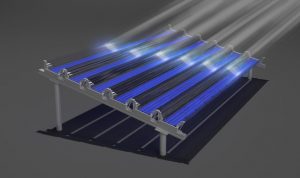 RenKube solar panel redirection
RenKube solar panel redirection
In early 2020, we realized that the unique nature of our panels (with an interleaved arrangement of solar cells and reflectors) would provide better lighting under the panels as well, rendering it suitable for agriculture, unlike traditional solar panels that throw a solid block of shadow that makes growth of vegetation impossible. AgriPV enables a symbiotic relationship between solar panels and crops. The transpiration from plants keeps the panels cool and improves energy generation by 5% and the canopy of the solar panels on the crops reduces irrigation needs, especially in a tropical climate like India. The concept of AgriPV was taking shape around the globe, in different arrangements like leaving gaps between every adjacent solar panel or raising the solar structure or growing crops in the inter-row gaps between solar panels, all of which limit the agriculture yield to 50% of the total area.
With RenKube’s technology, we can make 100% of the land usable for both agriculture and solar energy generation. This can completely transform the life of a farmer who can make solar their 3rd crop by leasing the land to solar developers that can bring in a fixed guaranteed income of ₹ 30,000/acre/annum, all the while continuing with their regular agricultural activities. We are actively working on this mission to bring in change in the lives of small and marginal Indian farmers.
Currently, our focus is on two product lines – the Agri PV panel “Krishi” that is designed for dual use in the same land and the second product is the energy efficient PV panel “Adi” that focuses on improving the energy yield in solar panels by up to 40% by capturing more sunlight with our patent-pending light redirecting prisms. Both the products align with our vision of driving the clean energy transition in India and making efficient use of available resources, whether for agricultural productivity or enhanced solar energy generation.
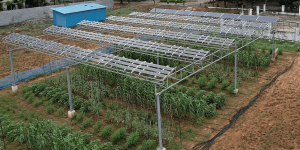 RenKube solar panels in the field
RenKube solar panels in the field
Can you share the key challenges your team faced during the transition from a software background to the world of deep tech and cleantech?
Indeed, the transition brought with it a steep learning curve, and adapting to a completely different field, with manifold challenges. In deep tech, especially clean tech, the gestation period for product development is considerably longer than in software. Our proprietary software gave us the prototype design as a CAD sketch, but to translate it to a physical glass piece was tough as it involved interacting with unskilled laborers at Firozabad, which is India’s glass hub. Sometimes, the software sketch was not amenable to manufacturing due to problems in making the mould or would result in too much material wastage and consequently increased the unit cost price. In a hardware product which has dependency on moulds this can easily take a few months. This is in sharp contrast to a software patch that can easily fix a bug and can be released within 3-4 weeks. Post prototype development comes the validation of our minimum viable product (MVP). To drive a transition of a clean tech idea from technology readiness level 4 to 6, it is quite capital intensive. But luckily for us the multiple government funds aided us in the early stages. Even after MVP, to commercialize the technology involves multiple stages of validation like product certification and field validation as the idea is proven from kilowatts (KW) scale to megawatt (MW) scale. It is also important for us to validate the working of our light redirecting prism in different latitudes, geographical conditions and land terrains. In the case of AgriPV, micro-climatic conditions of crops indigenous to the region are different; hence it’s important to validate the suitability of our panels for different crop types with extensive data collection.
Can you provide an overview of your funding status and sources?
The founders bootstrapped the company with their own funds for initial product development. We built three iterations of our physical prototypes in glass and established a small glass melting facility as an inhouse experiment center during Covid times. Currently, we have raised approximately ₹ 5 crores in investment, as a mix of equity and grants. We received grants from government sources such as Nidhi Prayas; Micro, Small & Medium Enterprises (MSME) grant from Indian Institute of Sciences (IISc); Biotechnology Industry Research Assistance Council (BIRAC) from IKP Knowledge Park, Hyderabad; TIDE 2.0 from SINE IIT Bombay; and a substantial grant from the US-India Endowment Fund for an innovative roofing product that aims to enhance energy generation from building-integrated PV.
What has been your experience with incubation centres?
As we progressed and developed our product, we realized the importance of understanding the business landscape, identifying the customer segment for our product, market research and fine tuning the story of our customer value proposition as we started interacting with different stakeholders. We participated in several incubation programs, such as Startup Nexus with the US embassy and collaborated with institutions like IISc and IIT Mumbai, which played a crucial role in our growth and catapulted us from researchers to technopreneurs.
What is the role incubation centres play in a startup?
Incubation centres provide startups with access to resources and equipment that they may not be able to afford individually, and often have specialized laboratories and equipment tailored to different industries, allowing startups to use them for experimentation and research.
Typically, government grants and funding are channelled through these centres, making it easier for startups to access these opportunities. They provide the last-mile connectivity between innovators and government funding sources. They also help startups navigate the complexities of grant applications and milestone-driven funding processes. After the grant is obtained, they provide guidance with monthly reviews, weekly seminars, access to industrial workshops and conferences, showcase opportunities to potential investors and also offer essential support, mentorship on both business and technical fronts.
In my journey, every incubation centre enabled me to build a strong network of entrepreneurs. I’ve been part of five different incubators over the last three years, and now I’m in turn serving as a mentor at these centres. Remember, this strong entrepreneur network is not just about exchange of information on funding opportunities; we also discuss nuances like handling grant money, GST compliance, TDS, and the intricacies of negotiating term sheets during fundraising. Having the support of experienced fellow entrepreneurs is invaluable.
Did these incubation centres have a structured curriculum, and what specific areas did they focus on in addition to technology?
Yes, the incubation centres provided a standard set of principles for running a business, covering topics like market discovery, understanding customers, fundraising, pitching, IP, legal issues, important clauses to check in a term sheet, manufacturing agreement, and mutual non-disclosure agreement (NDAs). However, some institutions offer more specialized knowledge. For example, we participated in programs like Climate Launchpad with Knowledge and Innovation Community (KIC), which focused on calculating the climate impact of our technology and also connected us with global cleantech entrepreneurs and forums. Another important value addition is networking. For instance, IKP knowledge park conducts an annual International Knowledge Millennium Conference (IKMC) which brings together innovators, investors and government bodies from all over India to brainstorm. Being a part of this event, I learnt immensely from others and gained valuable insights from their workshop.
For our AgriPV product, we took the help of PJTSAU’s AgHub Agri innovation pilot (AIP) program that helped us validate our value proposition for farmers with a systematic scientific study on the crop under the RenKube panels. They helped us bring together the right set of domain experts to plan and conduct the study and showcase our product in different agriculture-specific events and actively helped us in gaining traction. These incubation centres helped us gain a well-rounded education beyond just technology.
What did your collaboration with AgHub entail and how has it contributed to the success of your Agri PV project?
Our collaboration with AgHub has been instrumental in connecting us with the scientific community and experts in agricultural innovation. It all started when I met Dr. Kalpana Sastry, Managing Director, AgHub, in an online event for BIRAC grant writing. Then we connected and expressed our interest in the area of AgriPV and in collaborating with their renowned agriculture institute for our research. Dr. Praveen Rao, who was then the Vice Chancellor at Professor Jayashankar Telangana State Agriculture University (PJTSAU), was very keen on setting up an AgriPV pilot and a state-of-the-art pilot that would allow mechanized farm machinery to be used. Later, AgHub helped us identify the right scientific team to conduct crop studies and we designed the optimal structure that minimizes land loss and allows tractors to maneuver underneath. Our Agri PV structure was designed with a focus to incorporate best scientific practices in drip irrigation, farm machinery and our solar structures were fabricated in a way that they can be easily replicated across different farm locations.
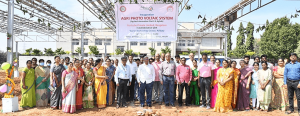 Pilot inauguration of Agri PV system at PJTSAU
Pilot inauguration of Agri PV system at PJTSAU
Can you share more details about the timeline of your pilot projects, particularly the one in PJTSAU and your collaborative efforts in validating the technology?
Our Agri PV pilot project began in PJTSAU in June 2022, and we commissioned the project in November 2022. During the COVID-19 pandemic, we worked on prototypes, particularly for our light redirection prisms. While measuring the flux underneath our panels, we realized it could be conducive for crop growth underneath. We then approached PJTSAU through AgHub for a pilot study to validate this and were eventually supported by a BIRAC grant from the government. We recognized the importance of building a replicable agricultural technology that could work across different regions and microclimatic conditions for commercialization. Though we initially considered focusing on specific crops like maize or groundnut, Dr. Parveen Rao advised us to diversify the crop variety for every season for simultaneous validation; so we included vegetables, groundnut and grams.
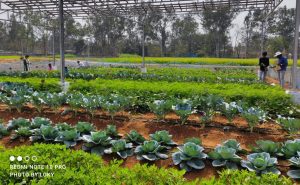 Crops under AgriPV Pilot.
Crops under AgriPV Pilot.
We implemented rigorous scientific practices throughout the project with the support of AgHub and PJTSAU. We used varied set of scientific instruments to measure various parameters, including photosynthetically active radiation (PAR), oxygen levels and every aspect of the photosynthesis process. We closely monitored the microclimatic conditions, humidity and soil moisture. To ensure accurate data collection, a research assistant from the University recorded and analyzed the data. Our results showed a remarkable 95% crop yield for Rabi and Summer seasons with this setup as compared to an open field cultivation for the same crop. Currently, we are continuing our research with Kharif crops. This approach is helping us fine-tune our narrative for Agri PV. But we realized during this process that adapting the technology to different geographical locations and varying land dynamics is both a challenge and an opportunity.
Customers often seek validation in multiple locations, and the questions around scalability and reliability arise. Each region has its unique conditions, and customization becomes critical to ensure the effectiveness of the technology. However, this adaptability also presents an opportunity for us to fine-tune our solutions and demonstrate their versatility in addressing different challenges, making it a valuable asset in the clean tech industry.
Can your technology potentially replace greenhouses in agriculture?
Our technology can complement greenhouse setups. Greenhouses offer controlled environments for crops that require specific conditions. However, our technology can provide energy for greenhouse operations and other agricultural post-processing needs.
Do small and marginal farmers face challenges in adopting AgriPV in their farms? If so, how can they be addressed?
The capex involved in a solar installation is typically ₹ 4 crores for a 3-acre farm, which is beyond the means of small and marginal farmers. This cost factor becomes critical when dealing with small land holdings, typically ranging from 2.5 to 5 acres, as is common among small and marginal Indian farmers.
Generally, traditional solar installations in traditional dry arid lands typically have a return on investment (ROI) in about five to eight years. However, implementing solar on agricultural land involves an additional capex of ₹ 50 lakhs/MW to raise the structure and provide necessary reinforcements, which depend on soil conditions, terrain, etc. These structural adjustments can extend the ROI period by a year. Balancing the potential benefits of our technology with the financial constraints of these farmers is crucial.
At RenKube, we are building a technology that will address these challenges and provide more energy generation to offset the additional capex investment for Agri PV. The dual use of land guarantees 120% energy generation and 100% agricultural yield which would provide an attractive ROI.
Though our goal is to empower marginal farmers, our initial approach is to work with high-income group farmers who have larger land holdings (100+ acres) due to their financial capability to invest in AgriPV. Once we demonstrate the benefits, we plan to collaborate with the government and suggest land policy recommendations for solar on agricultural land, provide preferential feed-in-tariffs for AgriPV, and provide upfront capex subsidy for solar developers to do AgriPV. This would build an ecosystem for Agri PV to flourish, where it is a win-win situation for everyone and we can extend the technology benefits to all the small and marginal farmers who make up the majority of the farming community in India by giving a guaranteed lease income.
Have you engaged with agricultural authorities or the Department of Agriculture to conduct trials or gather inputs regarding your technology’s application in farming?
Prior to our collaboration with AgHub, we had reached out to several agricultural universities involved in Agri PV projects. With our successful demonstration in PJTSAU University, we received multiple enquiries from government bodies like the Center of Excellence, Horticulture, India Agriculture Alliance from National Solar Energy Federation of India (NSEFI), Indo-German Energy Forum, and we are seeking their interest in piloting our innovative panel technology.
What are your views on the value proposition for industries considering the use of agricultural land for solar installations?
We believe industries can benefit significantly from using agricultural land for solar installations. They can cut their monthly electricity bills by 30-40% by financing an Agri PV project. They can pay a marginal rent of ₹ 30,000/acre/annum to the farmer for using the land, which in turn can give economic relief to small and marginal farmers. However, it’s important to note that this is a long-term investment. While the initial cost may be high, the ROI, especially for industries, can be quite favorable in the long run, making it a compelling proposition.
How feasible is it to install solar technologies for residential use and how much would it approximately cost?
For homeowners interested in installing solar panels for residential use, a 3-kilowatt system would cost around ₹2 lakhs, which can be recovered in approximately four years, considering the savings on electricity bills. Electricity tariffs are estimated to increase at a rate of 2.4%/year, totaling an 80% increase over the next 25 years, implying that solar power provides a cost-effective and sustainable solution for homeowners.
How do you see your enterprise benefiting the agricultural and renewable energy sectors in India?
Our enterprise has the potential to transform the Indian agricultural landscape. With our panels, farmers can continue their regular agricultural activities underneath the solar panels while leasing the land for solar energy generation. This provides a steady guaranteed income, helping them overcome the financial challenges posed by the vagaries of monsoon and climate change.
At the same time, solar developers now have access to land, thereby reducing pressure on them to acquire dry and arid sites. This concept can be extended to industrial districts, where MSMEs can invest in nearby farmland for solar power generation and contribute to a carbon neutral world while supporting local farmers. India’s ambitious target of generating 450 GW of renewable energy by 2030 requires innovative solutions. Our approach allows us to expand solar installations without competing for valuable land resources enabling a win-win scenario for the clean energy transition. This transition not only reduces carbon emissions but also improves the livelihoods of India’s farmers who are an important part of the country’s economy.
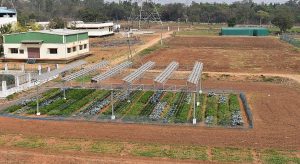 RenKube solar panels in the field.
RenKube solar panels in the field.
How was your journey as a woman in the startup world and while collaborating with different entities?
My journey as a woman in the startup world was quite unique. Our team had a balanced gender representation, with almost 50% women, which created a comfortable and supportive environment. Additionally, our long-standing ties with each other’s families provided a strong support system during tough times. The solar and manufacturing world has minimal representation by women, and I encountered some challenges in asserting myself. Convincing industry leaders required persistence and evidence-based discussions and extra effort to change the initial biases and gain trust. However, some of our strongest supporters in the supply chain have been women leaders, such as Ms Mirunalini Chellappan, director of our manufacturing partner Swelect Energy Systems. Ultimately, women supporting fellow women in their professional circles can be a catalyst for positive change.
Are there specific programs or quotas for women to access funding and secure deals?
There is growing recognition of the need to support women entrepreneurs. Some newer funds are being established with this focus. While venture capital funding specifically targeted at women-led startups is still limited, there is a positive shift happening in the ecosystem. Many incubation centres and accelerators, including those run by tech giants like Google, Amazon, and Qualcomm, have initiated programs to support women entrepreneurs that serve as a platform for women to connect, share their journey and inspire one another.
Would you say RenKube is at the forefront of remodeling renewable energy and agriculture in India? What policy challenges do you foresee and changes are you advocating for to allow the coexistence of solar-based innovation and agriculture?
Absolutely, policy challenges are essential for our work. Currently, in India, the use of agricultural land for solar installations faces policy restrictions due to concerns related to the potential loss to farmers and the impact on the food supply chain. However, our technology mitigates this problem by benefiting both farmers and solar developers. We are actively engaged as a part of India Agriculture Alliance with the Ministry of New and Renewable Energy (MNRE) to submit a draft recommendation on land policy changes that are supportive of Agri PV (watch our video on the RenKube pilot presented as part of MNRE’s India Agrivoltaic Alliance launch). Specifically, we’re advocating that governments should permit installation of solar systems exceeding 2 MW on agricultural land as long as at least 85% of the agriculture yield is maintained. This policy change would drive the rapid expansion of Agri PV in India.
Besides policy amendments, how do you think the government can promote this innovative approach, especially in the context of incentivizing solar on agricultural land?
The government can incentivize the adoption of Agri PV by offering preferential feed-in tariffs for energy generated from agricultural land. This will encourage developers and industries to invest in this approach, making it more economically viable. To ensure that farmers receive regular income from solar farming, we need a clear policy mandate and the involvement of nodal agencies in the disbursement of solar income. Additionally, capacity building centres can educate farmers about the benefits and feasibility of this approach. Collaboration with organizations like AgHub is also essential in bridging the gap between research and practical implementation that can transform the lives of people.
What lies ahead for RenKube?
Our long-term vision is to convert every surface that is exposed to the sun to an energy generating unit with attractive unit economics. We want to be the drivers for the proliferation of solar in all walks of life and go towards a carbon neutral world.
How has your enterprise been recognized?
We have received multiple awards for our innovation, such as the National Startup Award from the Government of India (2022), Startuppreneur award from the Confederation of Indian Industry and British Petroleum (2021). RenKube was also the only Asian company to chosen to present in the prestigious National Renewable Energy Laboratory’s annual Industrial Growth Forum event in the USA in 2022.
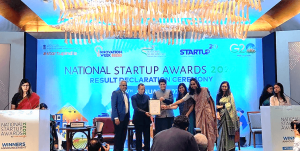 Receiving National Startup award 2022
Receiving National Startup award 2022
What’s your advice to fellow women entrepreneurs?
Dream big, and fly high and soar like an eagle far above all challenges. The Indian startup ecosystem is at this moment primed to nurture women entrepreneurs and the opportunities available are unlimited. So, dream big and kickstart your journey.
Acknowledgement: This interview was done as part of the IRRI-CRISP ongoing project ‘Mapping of Good Practices in Digital Innovations in India Supporting Women Agrientrepreneurs’.
 Bhuvana N, is a Consultant at the Centre for Research on Innovation and Science Policy (CRISP), Hyderabad. Her research interests include organizational ecosystems and effectiveness, institutional innovations, policy analysis, social networks and technological change. She can be reached at: bhuvanaditya7@gmail.com
Bhuvana N, is a Consultant at the Centre for Research on Innovation and Science Policy (CRISP), Hyderabad. Her research interests include organizational ecosystems and effectiveness, institutional innovations, policy analysis, social networks and technological change. She can be reached at: bhuvanaditya7@gmail.com
 Ditty Maria Dominic, Research Fellow at Centre for Research on Innovation and Science Policy (CRISP), Hyderabad, Telangana, India. She can be reached at: ditty794@gmail.com
Ditty Maria Dominic, Research Fellow at Centre for Research on Innovation and Science Policy (CRISP), Hyderabad, Telangana, India. She can be reached at: ditty794@gmail.com


 RenKube (
RenKube (


It is very interesting to see the way RenKube tried to address issues pertaining to the use of solar energy in agriculture. The idea to convert any surface exposed to the sun into an energy generating unit is highly appreciable. Glad that PJTSAU came forward to collaborate with RenKube to validate this innovation. The cost of installing solar panel in one acre of land is about Rs.4 crores which is beyond the scope of any farmer. Despite of its advantages, the scope of its use in agriculture appears to be very bleak. Even the Government institutions which have large agricultural farms hesitate to come forward because of this high initial investment. I am sure that the team RenKube must be trying to reduce the cost may be by compromising on one or two elements of this promsing technology.
Thanks to Drs Bhuvana N and Ditty Maria Dominic for bringing out this story of RenKube developing innovative solar panels.